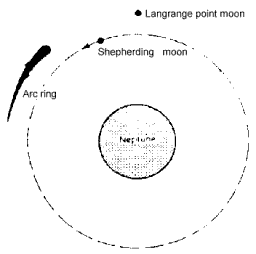 |
Science Frontiers ONLINE No. 44: Mar-Apr 1986 |
|
|
Neptune's partial rings
Neptune's rings cannot be seen directly. Instead, earth-based astronomers watch for occultations or dimmings of stars as they pass behind the rings. This seems straightforward enough in theory, but the occultations have been perplexing in practice. First, one member of a closely spaced double star will be occulted normally by the rings but its companion won't. Second, some terrestrial observatories will record an occultation but another a few thousand miles away will not. Such experiences have led to the hypothesis that the rings are discontinuous; that is, they are arcs rather than complete rings. Why should Neptune's rings be different from those of the other major planets? On speculation maintains that the arcs are the consequence of one or more recently satellites. Another hypothesis, by J.J. Lissauer, has the arcs gravitationally shaped and maintained by two moons, one of the shepherd type (as with Saturn's rings), the other at a Lagrangian point in the arc's orbit.
(Kerr, Richard A.; "Neptune's Ring Arcs Confirmed," Science, 230:1150, 1985. Also: Lissauer, Jack J.; "Shepherding Model for Neptune's Arc Ring," Nature, 318:544, 1985.)
Comment. The theories employing "shepherd" moons to gravitationally mold and maintain planetary rings have been weakened by the apparent absence of such bodies at the theoretically necessary locations around Saturn and Uranus. Also relevant is the possible youth of Saturn's rings. Neptune's rings may also be young. See SF#43 and ARL16 in our catalog: The Moon and the Planets. This volume is described here.
 | Neptune's arc ring may be controlled by two moons, a shepherd and a Lagrangian. Note that neither of these objects has ever been seen directly. |